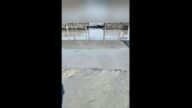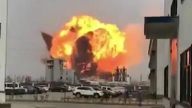【新唐人2012年7月26日訊】內蒙古的包頭是中國最大的「稀土」生產基地。儘管「稀土」是珍貴的礦產資源,但是污染危害性卻非常大。近期,法國媒體記者發自包頭的一篇報導說:「中國稀土殺死村莊」,文章介紹了當地由於生產稀土,大面積污染環境,造成居民、牲畜和土地受到毒害的情況。下面請跟著記者一起去了解。
法國《世界報》的文章說,飛到包頭,從天空向下看到一個湖泊,周圍許多溪水流入,但走到這個湖泊跟前卻發現,這片渾濁的水面是個10平方公里的巨大廢水池,周邊工廠向這裏排放處理17種稀土的廢水,水中沒有魚,也看不到水草。
文章中說,離這片廢水湖120公里處,是「巴彥敖包稀土礦」,礦裡的岩石「稀土」含量並不高,需要用化學酸水進行提取。而處理過「稀土」的廢水,含有眾多化學有毒物質和放射物質,這些物質會引發胰腺癌,肺癌和血癌。
而現在那裏方圓10里,散發著刺鼻的氣味。附近村民相繼患上癌症,村子裡一排排棕色房子都變成了廢墟。
四川環保人士陳雲飛表示,「稀土」提煉過程,對環境的污染和破壞力極大。而這個項目的具體危害性,是哪些專家的決策,卻都沒有向老百姓公布。
環保人士 陳雲飛:「它有些官員他就是有利可圖,他把錢一弄到手,他移民的移民,調的調,他因為有些是形象工程﹔還有一種就是官商勾結,就是官員在裡面有股份,他不管老百姓的死活,丟個爛攤子。」
據當地居民介紹,原先包頭那裏是一望無際的田野。1958年包頭鋼鐵廠開始開採稀土,到了1980年末,居民發現植物出了問題。
據《中國環境報》去年年中的報導指出,包頭鋼鐵集團尾礦庫水的滲漏已經對周圍5個村子、3000多戶農民造成嚴重影響,兩萬多畝耕地無法耕種。原「包頭市稀土研究院」院長馬鵬起表示,由於尾礦壩下面沒有防水層,如今尾礦壩的水正以每年300米的速度朝黃河滲透。
另外,居民透露,不但包頭鋼鐵公司開發「稀土」污染環境,之後的各種工廠和火力發電廠,也加重了這個地方的污染。當地居民呼吸著硫酸等化學蒸汽和煤灰。煤灰飄蕩在房屋周圍,伸出手能夠抓著粉塵,肉眼可見手裡的煤灰。農民飼養的牛、馬、山羊和雞,都被毒死了。
當地居民紛紛逃離,新光三村的2000村民現在只剩下300人,但家家都有病人。為了污染問題,村民向地方政府申訴了20年,後來終於得到經濟賠償的承諾,但這些承諾只有一部分兌現。
內蒙古包頭居民 郝女士:「我一說你也明白,政府太黑,沒人管,老百姓死活沒人管,死了也沒人管,別說污染啦!」
報導說,儘管學界一直呼籲政府重視包鋼尾礦壩「釷核素輻射」危及包頭周邊及黃河問題,但包鋼尾礦壩的安全隱患和環境污染問題,至報導當時仍未得到有效緩解。
環保人士 陳雲飛:「實際上它是投資了幾代人的資源,而且是污染了整個環境,高昂的代價,它去搞這種經濟,是不值得的,應該是譴責的。而且使我們的後代要去為這個事情買單。」
《中國環境報》還提出,包頭處於地層斷裂帶,一旦出現大地震或者大規模降雨致使尾礦壩決堤,周圍5個村莊、上萬名包鋼職工的生命安全將受到嚴重威脅。尾礦如果流入黃河將對黃河造成嚴重污染。
採訪編輯/唐睿 後製/肖顏
Rare Earth Minerals Turn Villages to Ruins
Baotou, Inner Mongolia is China’s largest
rare earth mineral production base.
Although it is a precious mineral resource,
rare earth imposes great dangers of pollution.
Recently, French media reported from Baotou.
Entitled “In China, rare earths are killing villages”,
the report highlighted massive environmental pollution.
It revealed the impact of the production of rare earth
minerals on local residents, animals and land.
The following is our report.
French media 『Le Monde』 reported from Baotou, stating
that by aerial viewpoint, it looks like a large lake,
fed by numerous tributaries. On site, it is actually
an opaque discharge covering an area of 10 km2.
Surrounding the industrial plants producing 17 minerals
are reject waste waters loaded with chemicals.
There are no fish or algae
The Le Monde article introduced that rock from Bayan obo
rare earth ore mine, located 120 kilometers away, are sent here for treatment.
The concentration of rare earth in the rocks is very low and
must be separated and purified by hydrometallurgical processes and acid baths.
In the effluent basin are exist all sorts of toxic chemicals
and radioactive elements such as thorium.
Ingestion of these toxins causes cancer
of the pancreas, lung and blood.
A pungent odor exudes within radius of 10 miles.
Local villagers have been suffering from cancer.
Rows of brown houses in the village
have been reduced to rubble.
Sichuan environmentalist Chen Yunfei indicates
that rare earth refining process causes great environmental pollution and destruction.
People are unaware of the specific dangers of this project,
and the specialists involved in the decision-making.
Chen Yunfei: “Some officials only work on the image projects
for profit. They relocate once the money has been made.
Some officials collude with the business, caring about
nothing but profit, leaving the mess for the public."
According to local residents, Baotou
used to be a vast grassland.
In 1958 the state enterprise Baotou Iron and Steel
Company began producing rare earth production.
By the end of 1980, locals found that the plant was in trouble.
Last year, China Environment News reported that
Baotou Iron and Steel Group’s tailing dam leakage has caused damage to five surrounding villages.
It has affected more than 3000 farmers,
and ruined more than 3,295 Acres of farmland.
Ma Peng, former Director of the Baotou Rare Earth
Research Institute, indicated that
due to the lack of a barrier below the tailing dam, the mining
waste is directly discharging into the Yellow River.
The discharge is at a rate of 300m per year.
The residents also said that further pollution has been
caused by other industries and thermal power plants.
These industries followed rare earth production
by the Baotou Iron and Steel Company.
Local residents have to breathe air saturated with sulfuric
acid and coal dust. Coal dust is airbourne around the houses.
Cows, horses, chickens and goats
are being killed by these poisons.
The locals have fled, and Xinguang Sancun village has now
decreased from 2000 villagers to 300. Every family is hit with illness.
After 20 years of complaints to the local government, the
villagers have finally won promises of financial compensation.
These have only been partially fulfilled.
Miss Hao, a resident of Baotou: “We all know.
The government is too dark.
No one cares about the people, whether
they live or die, not to mention the pollution."
For many years, there have been calls for attention
for the issue of Baotou tailing dam discharging thorium radiation to Baotou and into the Yellow River.
The hazards and pollution caused by the Baotou
tailing dam have never been effectively alleviated.
Environmentalist Chen Yunfei: “This is an investment
that has hurt several generations.
It has polluted the whole environment.
This high cost investment ought to be condemned.
Our future generations are going to suffer for it."
China Environment News indicated that Baotou
is located in the stratum fracture zone.
In the event of a major earthquake or large-scale rainfall,
the rupture of the tailing dam will threaten the surrounding
five villages, as well as tens of thousands of lives
of the Baotou Iron and Steel workers.
If the tailings flow into the Yellow River,
it will cause serious pollution to the river.



























